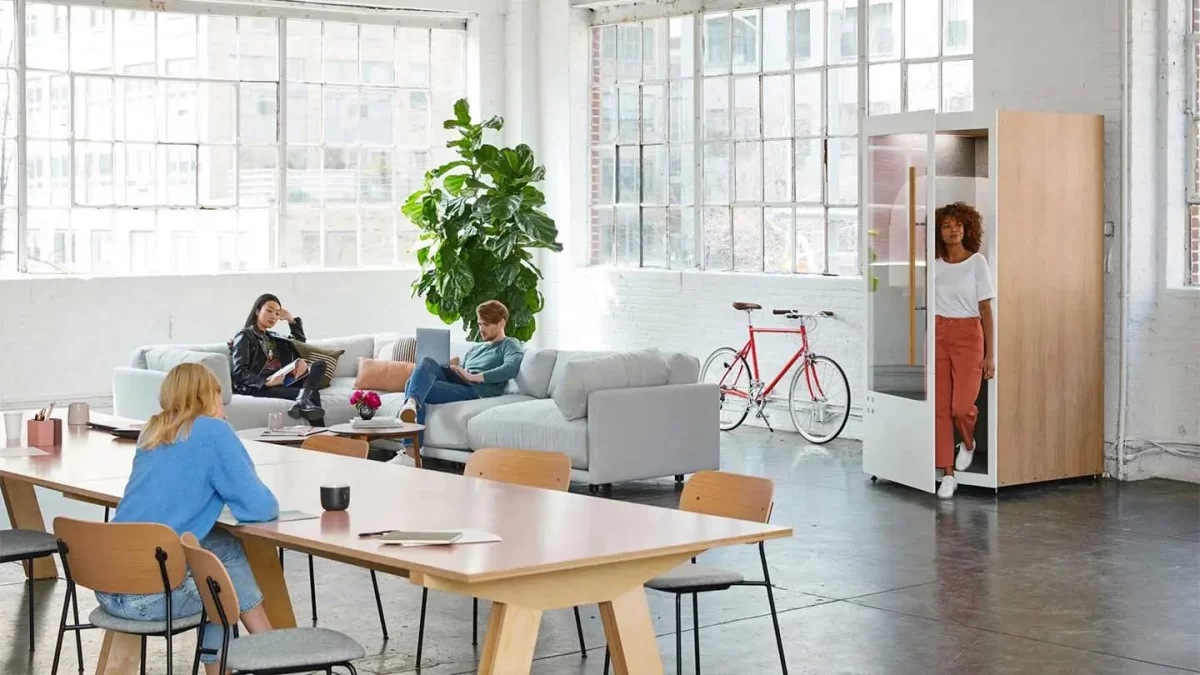
As the workplace landscape continues to evolve, there’s often confusion about what constitutes a shared workspace. Is it a place where multiple people work at once? Or is it an area where many employees work at different times? What about a place where employees from different companies work side by side? What is shared workspace?
“A shared workspace” vs. “a collaborative workspace”
The biggest misconception about shared workspace is that it’s shared by many people at the same time. This is actually what’s referred to as “collaborative space.” Understanding the difference means understanding the qualifiers: shared workspace vs. collaborative workspace.
- A shared workspace is shared by many people at different times. The workplace is static; the occupants are dynamic.
- Many people use a collaborative workspace at the same time for the purpose of working together.
A shared workspace implies an individual occupant using space for a limited time. When they leave, that workspace will become occupied by someone else, instead of sitting idle.

Coworking, shared workspaces, and shared offices
The rise of coworking has created confusion between the meanings of coworking, shared workspaces, and shared offices. While coworking and shared workspaces can be used virtually interchangeably, both are different from shared office spaces.
Shared workspaces (coworking spaces) are workstations rented by remote employees, freelancers, gig workers, consultants, and anyone else who may not have a central office—one space for one individual. Shared office space is a much larger workplace rented for many people in a similar fashion. Where a freelancer may rent a coworking space, a startup may periodically rent shared office space to bring its entire team together.
Shared office space also differs from shared workspaces in the amenities and resources offered. Because these areas generally support small companies, they’re outfitted with perks, tech, and features for a broader group of people. They’re also a lot more spacious—with a price to match.
Benefits at every level
Understanding the differences in terminology for each type of modern office space is advantageous in leveraging them. If you understand your need for space, it’s easy to spot the right solution and see the benefits of coworking or shared office space. Here’s a quick look at the benefits of each type of space:
- Collaborative workspace: You still maintain the space in-house, allowing you to use it however best suits your company’s current needs. Use collaborative workspaces to stage a big project, ping-pong ideas back and forth, meet with high-profile clients, teach a seminar, or any other task that involves multiple people in the same accommodating space.
- Shared workspace: Employees without a permanent desk get access to an individual space where they can work supported on an ongoing or as-needed basis. They get the freedom to use the workspace on their terms, while companies unburden themselves of costly commercial leases.
- Shared office space: Startups and agile companies without the need for permanent office space can keep overhead costs low, while still utilizing a traditional workplace setting. They also get access to workplace resources and a professional setting that’s useful for meeting with clients or collaborating on large initiatives.
There’s scale built into this model. Collaborative workspaces benefit companies retaining their own real estate, which maximizes space utilization opportunities. Shared workspaces benefit individuals by giving them flexibility. Shared office spaces benefit groups that exist somewhere in-between an established company and freelancers.
The landscape is painted by terminology
Pairing the correct terminology to the many definitions of modern workspaces legitimizes them. It creates industry-wide consensus and allows for standardization in how these spaces are perceived and operated. Like the coworking movement is vital to the evolution of the way we work, the vocabulary used to describe it is equally as important.
Understanding terminology also helps make sense of this emerging industry. When you understand the difference between shared workspace and a shared workplace, you’ll also understand why the latter costs as much as four times more in many cases. Likewise, when evaluating the cost of collaborative space vs. coworking subscriptions, you’ll be able to do a proper cost-benefit analysis. It’s all about having a definite understanding.
Be cognizant when reading industry articles and reports that use this terminology. Not everyone is on the same page as to meaning and vocabulary. Look for context to make sure terms aren’t interchangeably used. A firm grasp on industry terminology will lead to better realization of the way these spaces are presented, portrayed, and capitalized by your business.
Keep reading: The benefits of coworking.



